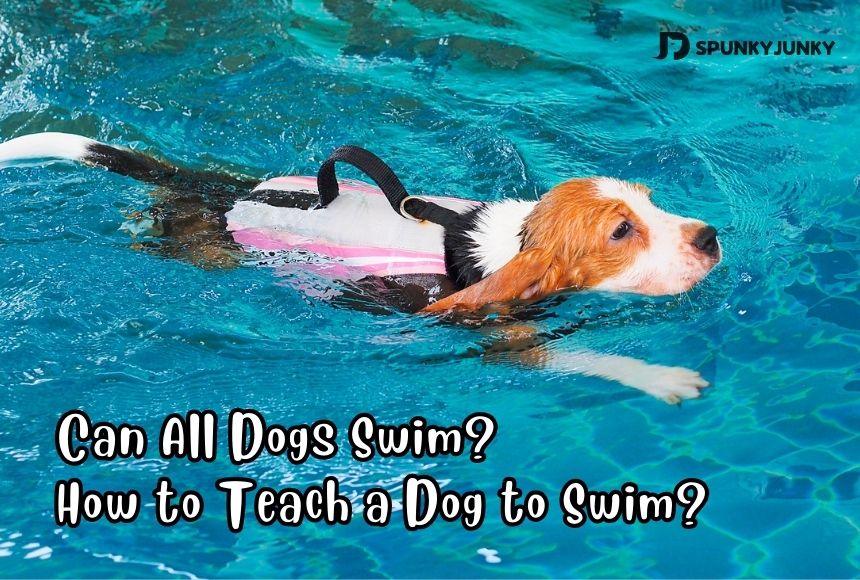Hi! Dear dog owners! Does your dog like to play in the water?
For many dogs, water is an irresistible playground. A sparkling pool or tranquil lake often excites them.
But can all dogs swim? No. Although dogs seem to be born with a natural ability to swim, not all puppies have this aquatic ability. Some dogs can paddle like pro athletes, while others are afraid to dip their paws in the water.
If you're wondering why? Join us as we learn about the complex relationship between dogs and water! We'll explore which breeds are natural swimmers and which are not and provide insight into how to teach your dog to swim.
Can All Dogs Swim?
Can all dogs swim? No. Although most people assume dogs have swimming skills, many are not natural swimmers.
Whether a dog can swim depends on many factors, such as breed, personality, experience, preferences, etc. Some dog breeds, such as Labrador retrievers with webbed paws and waterproof fur, are obvious swimmers. Bulldogs, who are bulkier, are not good at swimming.
In addition to breed, a dog's personality and past experiences affect whether a dog can swim. So, can all dogs swim? You already know the answer.
So, which dogs can swim and which dogs can’t? Let's continue reading!
What Dogs Can Swim?
Some dog breeds are natural water lovers, often thanks to their breeding history and physical attributes.

● Portuguese Water Dogs: Originally bred to assist fishermen, they are known for their intelligence and love of swimming.
● Irish Water Spaniels: They have distinctive curly coats and excel in retrieving objects from the water.
● American Water Spaniels: They are Wisconsin's state dog and are great retrievers and sensitive companions.
● Spanish Water Dogs: Originally waterfowl retrievers, they thrive on swimming and water-related activities.
● Golden Retrievers: They are famed for their affectionate nature and often enjoy splashing around thanks to their water-repellent coats.
● Labrador Retrievers: They are among the best swimmers with muscular bodies and otter-like tails.
Dogs of these breeds are strong swimmers and often find great joy in their adventures in the water.
However, not all dogs are so keen on swimming. Some breeds of dogs may not be physically suited to swimming or may not derive pleasure from swimming.
What Dogs Can't Swim?
Now, it’s time to learn which types of dogs are unsuitable for swimming. See if your dog is one of them.

● Bulldogs: Bulldogs have flat faces, barrel-shaped bodies, and short legs, which make them less likely to swim.
● Pugs: Due to their flat faces, they may have difficulty breathing when swimming and keeping their heads above the water.
● Bull Terrier: Although Bull Terriers are energetic, they may struggle due to their short legs and deep chest.
● Basset Hound: The Basset Hound has a large head and short legs, making it unsuitable for swimming. Their floppy ears can also become infected when wet.
● Boxers: Despite their athletic gifts, Boxers face challenges when swimming due to their flat face.
● Corgis: Corgis have long bodies with barrel-shaped chests and short legs, hindering their swimming ability.
● Dachshund: Dachshund has a slender body, short legs, poor swimming ability, and will tire quickly even in shallow water.
● Shih Tzu: Shih Tzus are a smaller breed with short muzzles, thin legs, and long fur that can make swimming difficult and even cold.
The above breeds are not suitable for swimming due to their physical conditions, so please take care of them when taking them around the water.
How to Teach a Dog to Swim?
Suppose you want your dog to have fun playing in the water or help your dog get healthier by swimming. Then, teaching your dog to swim is a good way. This can be a fun and rewarding experience for you and your dog, but it requires patience and a positive attitude.
Now, let’s take a look at how to teach your dog to swim:
1. Choose the Right Location:

Choose calm, shallow water, such as a pool with a graduated entrance or a calm lake. Avoid areas with strong currents or rough waves, such as the ocean.
2. Let Your Dog Explore:

Allow your dog to approach the water at his own pace. Use treats, toys, or praise to encourage them to dip their paws in the water.
3. Use a Gradual Entry:

If your dog is a little afraid of water, you can slowly walk your dog into the water. Always have your dog with you and provide support when your dog needs it.
4. Offer Support:

As your dog becomes accustomed to shallow water, provide gentle support by placing your hands under his belly or using a buoyancy aid such as a life jacket. This gives them confidence in the water.
5. Positive Reinforcement:

Reward your dog's efforts and progress with treats, praise, and encouragement. This helps them associate swimming with positive experiences.
.
6. Increase Depth Gradually:

Once your dog is comfortable in shallow water, slowly increase the depth. Always be aware of their comfort level and provide support as needed.
7. Encourage Movement:

Use your hands or toys to encourage your dog to paddle and move through the water. Reward their efforts with praise and treats.
8. Supervise and Rest:

Always supervise your dog while they swim, watch for signs of fatigue, and provide breaks. Make sure the swimming area is safe and accessible for your dog to exit at any time.
Based on the above 8 steps, you can help your dog learn to swim. Remember not to pull your dog into the water when he is new to the water.
In addition, you can let your dog watch the performances of outstanding "swimming champions" or let them play with water-loving friends. These are great for getting your dog interested in swimming.
Water Safety Tips for Dogs
It's important to teach your dog how to swim, but it's even more important to keep your dog safe around water, whether it's a swimming pool, lake, pond, or ocean.
Here are some dog water safety tips:
● Temperature matters: Before letting your dog swim, check the water temperature t least 100°F. Cold water can cause problems like cold tail or hypothermia, especially in puppies.
● Be aware of water toxicity: Water intoxication can occur when a dog swallows too much water. Symptoms include vomiting. So keep your dog’s swimming times short, around 10 minutes.
● Beware of dangers: When dogs swim in natural water bodies, be wary of creatures such as water snakes and snapping turtles. There may even be crocodiles in some areas.
● Beware of Fish Hooks: Baited fish hooks can be dangerous to dogs in natural waters. Dogs may accidentally bite them or get scratched by them. If this occurs, emergency veterinary care must be sought.
● Supervision is key: Never leave your dog alone in or near water, and be aware of potential dangers.
● Provide shade and water: Ensure your dog has access to shade and fresh, clean drinking water outdoors. Avoid letting your dog drink water from swimming pools, lakes, or oceans. Also, use sunscreen specifically formulated for dogs to protect your dog from sunburn.
● Alternative cooling: If your dog doesn't go swimming, consider a cooling jacket, plastic kiddie, or dog pool. To make your pool less slippery, use a kennel deck or rubber drainage mat for traction.
Based on the above 7 tips, you will provide your dog with a safe swimming environment. Safety and your dog’s comfort are always prerequisites for swimming.
The End
"Can all dogs swim?" Of course not.
But every dog can enjoy water in his or her unique way whether your puppy is a water-loving Labrador or a water-phobic Bulldog, their health and safety matter.
Teaching your dog to swim can be a rewarding experience filled with patience, motivation, and many rewards. Keep them safe by watching temperatures, monitoring water toxicity, and understanding potential hazards.
So when the sun shines and the sea beckons, create unforgettable memories with your dog, one stroke at a time.
So when the sun shines and the sea beckons, create unforgettable memories with your furry friends, one stroke at a time.






